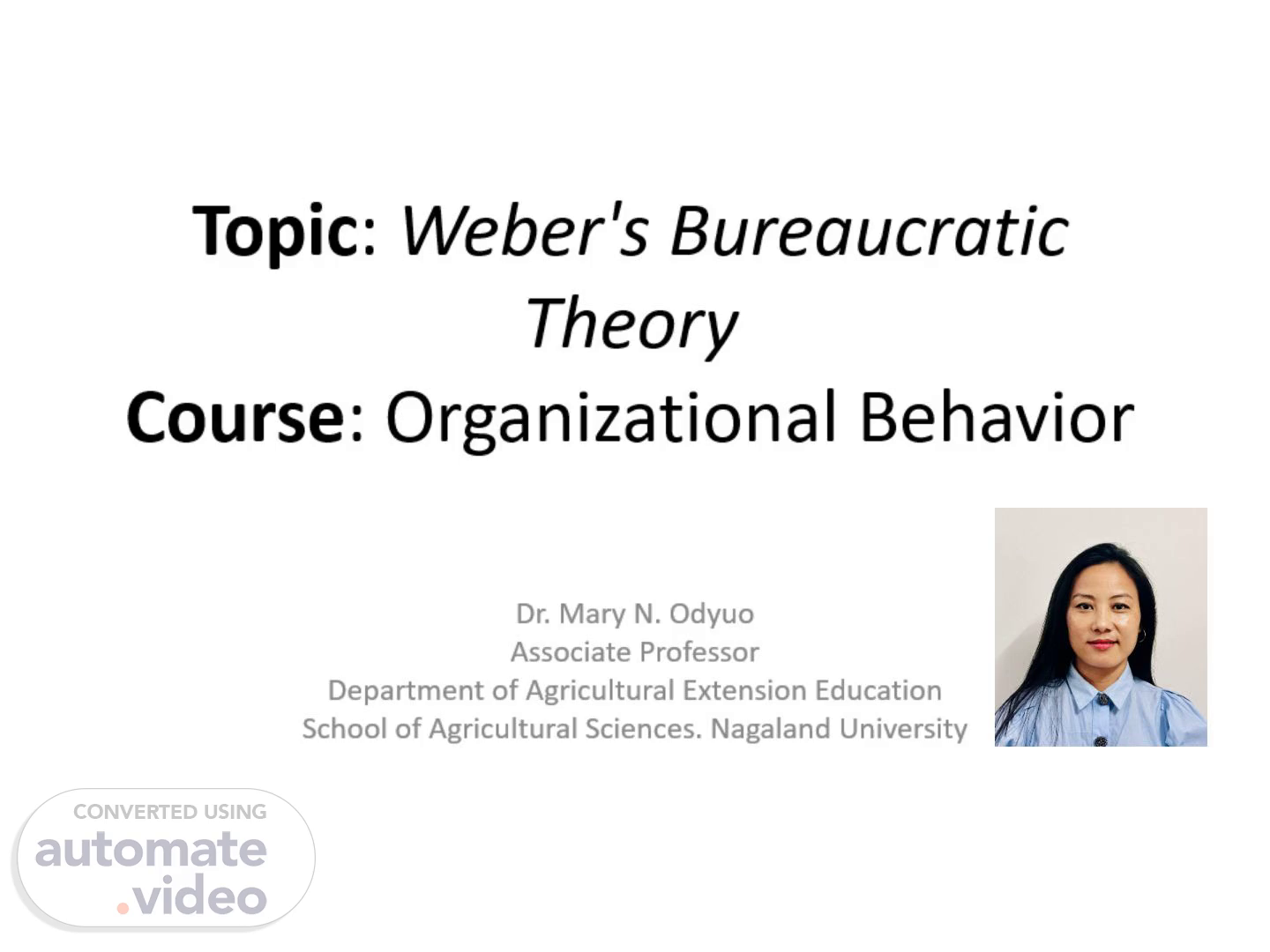
Topic: Weber's Bureaucratic Theory Course: Organizational Behavior
Scene 1 (0s)
[Audio] Topic: Weber's Bureaucratic Theory Course: Organizational Behavior Dr. Mary N. Odyuo Associate Professor Department of Agricultural Extension Education School of Agricultural Sciences. Nagaland University.
Scene 2 (16s)
[Audio] Weber's Bureaucratic approach The father of modern sociology, Max Weber, developed the bureaucratic management of organization. According to this branch of classical theory, an ideal organization or bureaucracy, has a hierarchical structure of management with clearly defined rules and regulations. Labor is divided and relationships are impersonal. Although the classical theory of management is not prevalent in the modern age, certain principles and branches of the classical theory still find use in today’s organizations, especially Weber’s principles of bureaucratic management..
Scene 3 (53s)
[Audio] . [image] BUREAUCRATIC THEORY Bureaucratic theory explains the setup, operation, and management of organizations as formal, rational, well-organized, hierarchical systems. DEFINITION Webeds bureaucratic theory mirrors two key phenomena of the early 20th century: professionalization and rationalization: 1. Professionalization: secure and efficient legal, financial etc. transactions. 2. Rationalization: organization based on reason and objectivity rather than emotions or arbitrariness. SIX PRINCIPLES OF BUREAUCRACY Division of labor (specialization) Formal selection 20 Impersonality 30 Hierarchical authority relationship COO So gormal rules and regulations 60 Career orientation.
Scene 4 (1m 15s)
[Audio] Principles of Bureaucratic Organization 1. A formal hierarchical structure /Formalized rules: A formal hierarchy is the basis of central planning and centralized decision-making. The authority hierarchy provides formalized rules for who gets to give orders to whom within an organization. 2. Division of labor/: A clear division of labor and specialization helps to prevent confusion and wasted time by defining each role's responsibilities. contd…..
Scene 5 (1m 49s)
[Audio] Principles…. 3. Rules-based management: The company uses rules to exercise control. 4. Impersonal: Employees should not interfere with the affairs of other employees, managers, or the organization. Communication should not involve emotions, personal sharing, or feelings. 5. Functional specialty organization: Specialists do the job. 6. Employment-based on Technical Qualifications – Selection as well as the promotion of employees is based on technical qualifications and skills..
Scene 6 (2m 29s)
[Audio] Limitations of Bureaucratic Organization The rules are inflexible and rigid. Informal groups do not receive any importance. In current times, informal groups play a huge role in most business organizations. Typically, bureaucracy involves a lot of paperwork which leads to a waste of time, money, and also effort. The rules and formalities lead to an unnecessary delay in the decision-making process. Contd….
Scene 7 (2m 55s)
[Audio] Limitations… While Government organizations can benefit from a bureaucratic structure, business organization need quick decision-making and flexibility in procedures. Therefore, it is not suitable for the latter. While the technical qualifications of the employee is an important aspect of his promotion, a bureaucratic organization does not consider the employee’s commitment and dedication. There is limited scope for Human Resource management. Coordinating and communicating is difficult..
Scene 8 (3m 29s)
[Audio] Thank you. Thank you.